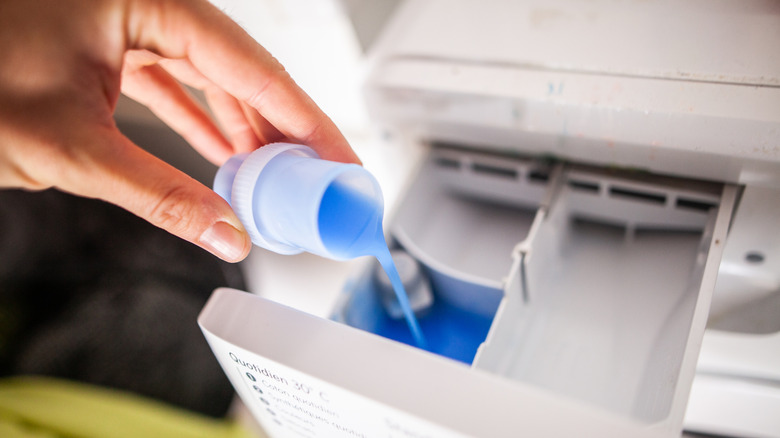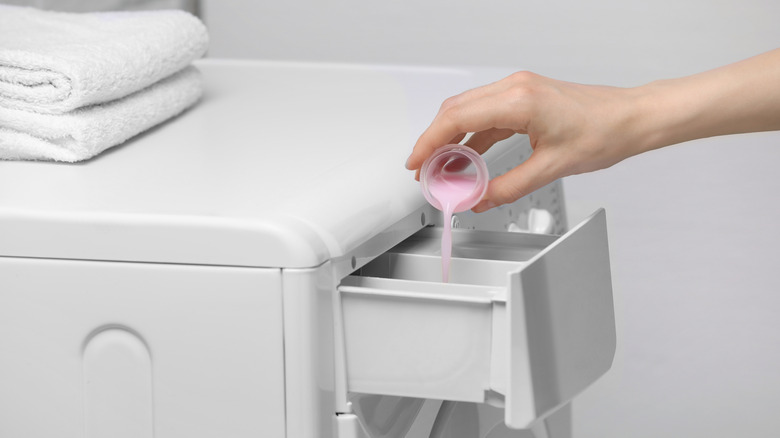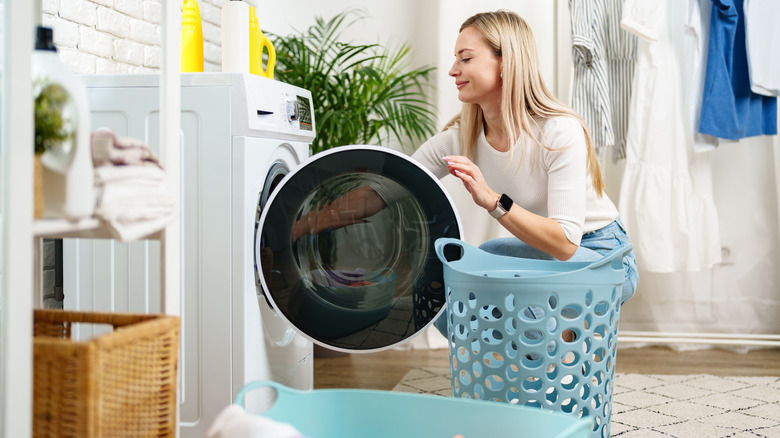What Happens If You Put Fabric Softener In The Laundry Detergent Slot?
Your washing machine likely features several compartments or drawers, each meant for a specific laundry product. You should use the appropriate product in its respective compartment, but what happens if you put liquid fabric softener in your laundry detergent slot? One-time accidental use of softener in the detergent cup is nothing to worry about, but you shouldn't regularly swap the products. Fabric softener is simply not a good substitute for laundry detergent, and using it as such won't get your laundry clean.
Each of your washer's slots features programming meant for a particular use and an associated release process. For the best results, you should use the correct compartment — otherwise the machine will release the wrong product at the wrong time. Fabric softener works on fibers as a conditioner, and it's released during the rinse cycle of the wash process. As the name implies, its lubricating ingredients help soften fabrics to reduce the chances of pilling or fading, so your clothes and linens don't wear out as quickly. Softener also works on the fabrics to prevent static cling and lessen wrinkles. Adding fabric softener to your laundry at the wrong time will only make it less effective.
Why it's important to use fabric softener in the right slot
If fabric softener is used in the detergent cup, it will be released during the wash cycle instead of the rinse cycle. Since softener doesn't offer detergent's stain-fighting and cleaning power, your laundry isn't really clean — it only smells clean. If you notice you added softener to the detergent cup before running the load, just remove the detergent cup and wipe it clean, then add detergent and run the load like normal. However, if you realize your error after the load has started, you will need to wash the load again with detergent once it's completed.
If you accidentally combine softener and detergent in the same cup, your clothes will still get clean. However, the effectiveness of the detergent will be diminished and the softener's conditioning properties will be largely neutralized. In this case, it's best to re-run the load. What if you slip and put detergent in the softener slot? If you realize your error in time, you can remove and clean the softener cup, then start a new cycle. If it's too late, though, the detergent will release during the rinse cycle and permeate your clothes, which can damage the fabric and cause skin irritation. If this happens, you should put the load through another rinse cycle or two to rinse out the detergent.
Using fabric softener correctly and what not to use it on
There's a correct way to use laundry additives like softener, and following the directions gives you clean, fresh laundry. Using the softener in place of detergent won't harm your washing machine, but it could leave residue buildup, as can mixing it with detergent. The laundry staple is known to cause mold and mildew in the washing machine, especially with frequent use in low-temperature wash cycles, because it doesn't dissolve well. To eliminate any mold, run an empty cycle on the hottest water setting with vinegar in the detergent compartment, then leave the door open to let the interior dry.
It's also worth noting that fabric softener doesn't work for all fabrics and shouldn't be used for everything. Towels should never be washed with fabric softener because the residue it leaves makes them less absorbent. It also doesn't work well with swimsuits and may weaken the suit's synthetic fibers. Definitely keep it away from your wool sweaters, as fabric softener can leave a coating that affects the wool's breathability and strips away its natural oils. If you have young children, don't use softener with sleepwear or other baby clothes. These garments have flame-retardant properties, and the softener can reduce them.


